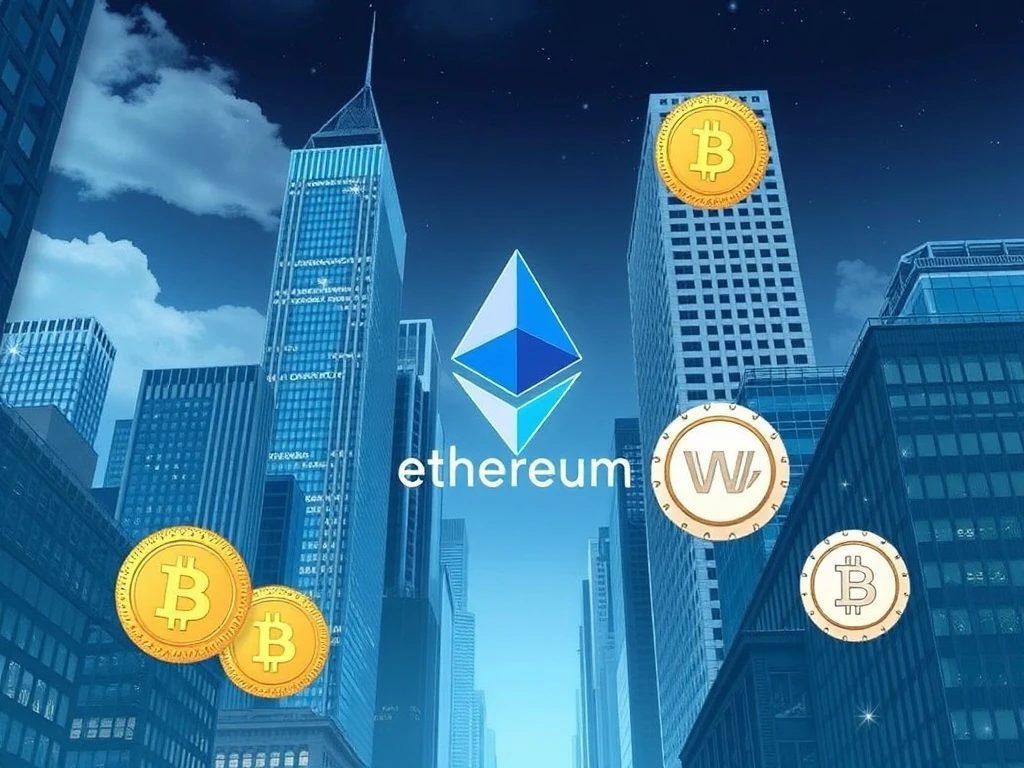Unleashing Ethereum’s Potential: Why Wall Street’s Institutional Interest is Surging

Ethereum (ETH) has recently shown remarkable strength, outperforming Bitcoin and the broader crypto market with a significant price surge. Yet, at $3,400, it still trades considerably below its 2021 peak. While Bitcoin has entered new price discovery, many believe Ethereum has much more room to run, especially as powerful new narratives take hold. Gone are the days when NFTs and DeFi alone drove Ethereum’s appeal. Today, a profound shift is occurring: Wall Street is piling into Ethereum, seeing it as the bedrock for the burgeoning digital dollar economy, driven by the expansion of stablecoins and real-world assets (RWAs).
Why is Wall Street Piling into Ethereum Now?
The narrative around Ethereum is evolving from a mere utility token to a foundational pillar of the global financial system. This transformation is largely fueled by its pivotal role in the stablecoin ecosystem and the rapidly expanding tokenization of real-world assets. These developments are repositioning ETH not just as a cryptocurrency, but as a reserve asset, a store of value, and even ‘digital oil’ for a new financial paradigm. This growing institutional interest is a key driver for Ethereum’s current and future growth.
Historically, major bull runs are underpinned by compelling stories. For Ethereum, the current story is its deep alignment with traditional finance (TradFi). The market’s excitement has shifted from speculative JPEGs to tangible applications that bridge the gap between blockchain and conventional financial instruments. This strategic pivot is attracting significant capital and attention from institutional players.
Stablecoins: Ethereum’s Foundation for the Digital Dollar Economy
Stablecoins have emerged as a critical innovation, offering a digital form of fiat currency that is globally accessible and usable without traditional banking intermediaries. Since 2020, stablecoin adoption has exploded, now exceeding $200 billion in market capitalization. Ethereum stands at the forefront of this revolution, hosting over 54% of all stablecoins, making it the undisputed leader in this crucial sector.
A recent report by Electric Capital underscores Ethereum’s leadership in stablecoin issuance and settlement. They identify three key criteria for a robust stablecoin platform, all of which Ethereum consistently meets:
- Global Accessibility: Anyone with internet access can hold and use digital dollars.
- Institutional Security: Ethereum’s robust, decentralized network provides unparalleled security.
- Political Neutrality: As a decentralized public blockchain, it offers a politically neutral infrastructure.
While competitors like Tron have gained ground, Ethereum’s recent fee reductions, thanks to network upgrades and reduced congestion, are allowing it to consolidate its role as the core layer for the onchain dollar economy. This strategic move makes it more attractive for high-volume, institutional-grade stablecoin transactions.
Moreover, yield-bearing stablecoins, which allow users to earn passive income on their digital dollars, are the fastest-growing segment within this space, exceeding $4 billion in market cap. Ethereum’s robust DeFi ecosystem is perfectly positioned to facilitate the growth and innovation of these financial instruments, further cementing its role as the backbone for a new era of digital finance.
Real-World Assets (RWAs): The Next Frontier for Institutional Interest?
The tokenization of Real-World Assets (RWAs) represents a monumental opportunity for blockchain technology, and particularly for Ethereum. RWAs are tangible or intangible assets from the traditional financial world, such as real estate, bonds, commodities, or even intellectual property, that are represented as tokens on a blockchain. This process unlocks liquidity, transparency, and fractional ownership for assets that were traditionally illiquid and difficult to trade.
Institutions are increasingly exploring RWAs for several compelling reasons:
- Expanded Investment Opportunities: Access to a wider range of assets in a digitized format.
- Increased Efficiency: Streamlined processes for trading, settlement, and compliance.
- Enhanced Transparency: Blockchain’s immutable ledger provides clear ownership records.
- Fractional Ownership: Enabling smaller investments in high-value assets.
Ethereum’s battle-tested security, extensive developer community, and established infrastructure make it the preferred platform for issuing and managing tokenized RWAs. As regulatory frameworks evolve to accommodate these digital assets, Ethereum is poised to become the primary settlement layer for a multi-trillion dollar market, bridging the gap between traditional finance and decentralized ecosystems. This convergence of TradFi and DeFi through RWAs is a significant driver of renewed institutional interest in the Ethereum ecosystem.
Beyond Utility: Ethereum as a Reserve Asset and Store of Value
As the stablecoin and RWA ecosystems expand, so does ETH’s function as a reserve asset. Similar to how Treasurys or gold serve as collateral and settlement assets in traditional finance, ETH is increasingly seen as providing foundational support for the digital economy. Its characteristics – scarcity, non-custodial nature, staking capabilities, and deep integration within DeFi – make it a strong contender for this role. ETH already backs over $19 billion in loans within decentralized finance protocols, demonstrating its utility as collateral.
Electric Capital posits that in the long term, ETH could absorb a share of the colossal $500 trillion global store-of-value market. Unlike Bitcoin, which primarily offers resilience, Ethereum also provides native yield through staking, a trait highly favored by US households who hold significant wealth in dividend-paying equities but less in gold. This yield potential adds a compelling dimension to ETH as a long-term store of value for institutional portfolios.
Fidelity’s latest report further reinforces this perspective, arguing that blockchains like Ethereum are best understood as sovereign digital economies rather than mere Web2 platforms. In this framework, ETH acts as the base money, coordinating decentralized participants and enabling the consumption and production of services. Fidelity suggests a GDP-like framework to assess blockchain economic activity:
- “Consumption”: Protocol fees generated on the network.
- “Government”: Spending by entities like the Ethereum Foundation.
- “Investment”: ETH staking and changes in DEX liquidity.
- “Net Exports”: Value flows across blockchains, to the physical world (DePIN), and to traditional economies (stablecoin issuance).
For Fidelity analysts, ETH serves as both a medium of exchange and a robust store of value within this expanding paradigm. The data supports this thesis: daily active wallets on Ethereum now exceed 2.5 million, and transaction counts have reached an all-time high of approximately 19 million, indicating robust and growing activity within this digital economy.
Fueling the Future: ETH as the Digital Oil of the Onchain Economy
A third compelling perspective, outlined in a recent report by leading Ethereum stakeholders, frames ETH as a productive, yield-bearing commodity at the heart of the onchain economy. As the global financial system shifts towards a fully digital, decentralized infrastructure, Ethereum is emerging as the core settlement layer, security provider, and reserve asset. While Bitcoin is often termed “digital gold,” Ethereum uniquely combines value storage with unparalleled utility, powering computation and decentralized finance, all while offering native yield through staking.
The “digital oil” analogy captures ETH’s multifaceted roles:
- Fuel: ETH is burned with every transaction, reducing its supply.
- Collateral: Roughly one-third of its supply secures stablecoins, tokenized assets, and DeFi protocols.
- Scarcity: Its issuance is capped at around 1.51% annually, ensuring long-term scarcity.
The report also addresses a common misconception regarding Ethereum’s fee revenue, which has seen a dramatic decline from its 2021 peak. Rather than a failure, this reduction is presented as a strategic move to scale. Similar to how tech giants like Amazon or Tesla prioritized long-term adoption over short-term revenue in their early growth phases, Ethereum strategically pushed down transaction costs via Layer 2 (L2) scaling solutions. While this temporarily suppressed fee income, it significantly expanded Ethereum’s total addressable market, paving the way for mass adoption and, ultimately, increasing both ETH burn and staking rewards in the long run. This scaling strategy is crucial for handling the massive volume expected from institutional use cases within the digital economy.
The Unrivaled Edge: Why Ethereum Dominates Institutional Adoption
While the underlying logic of these analyses can be applied to other smart contract platforms, each report subtly or explicitly points to Ethereum’s clear advantage. This edge stems from its “industrial-grade” quality. Ethereum remains the most decentralized blockchain, boasting the most secure protocol and the most developed ecosystem in the entire space. These attributes are paramount for institutional players who prioritize security, reliability, and a proven track record.
Even Ethereum’s historical scalability limitations, once a significant barrier, are now effectively mitigated by robust Layer 2 solutions. These L2s enable higher transaction throughput and lower costs, making the Ethereum ecosystem more attractive and feasible for large-scale institutional adoption. Just as institutional interest fueled Bitcoin’s rally in this cycle, it is now poised to do the same for Ethereum, driven by its undeniable utility and strategic positioning within the evolving global financial landscape.
The Road Ahead for Ethereum and Traditional Finance
The convergence of Wall Street and Ethereum is not just a fleeting trend; it represents a fundamental shift in how traditional finance views and integrates with decentralized technology. With stablecoins providing the digital dollar rails and real-world assets offering new avenues for tokenization, Ethereum’s role as a foundational layer for the digital economy is becoming undeniable. Its evolution into a reserve asset, a robust store of value, and the ‘digital oil’ powering the onchain ecosystem positions it for continued, significant growth. As institutional players continue to recognize and invest in Ethereum’s potential, its journey towards becoming a cornerstone of the global financial system looks increasingly certain. The future of finance is digital, and Ethereum is leading the charge.
This article does not contain investment advice or recommendations. Every investment and trading move involves risk, and readers should conduct their own research when making a decision.










